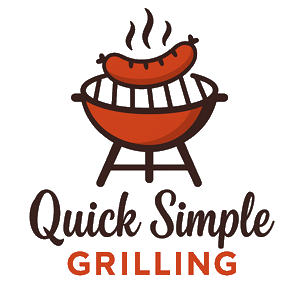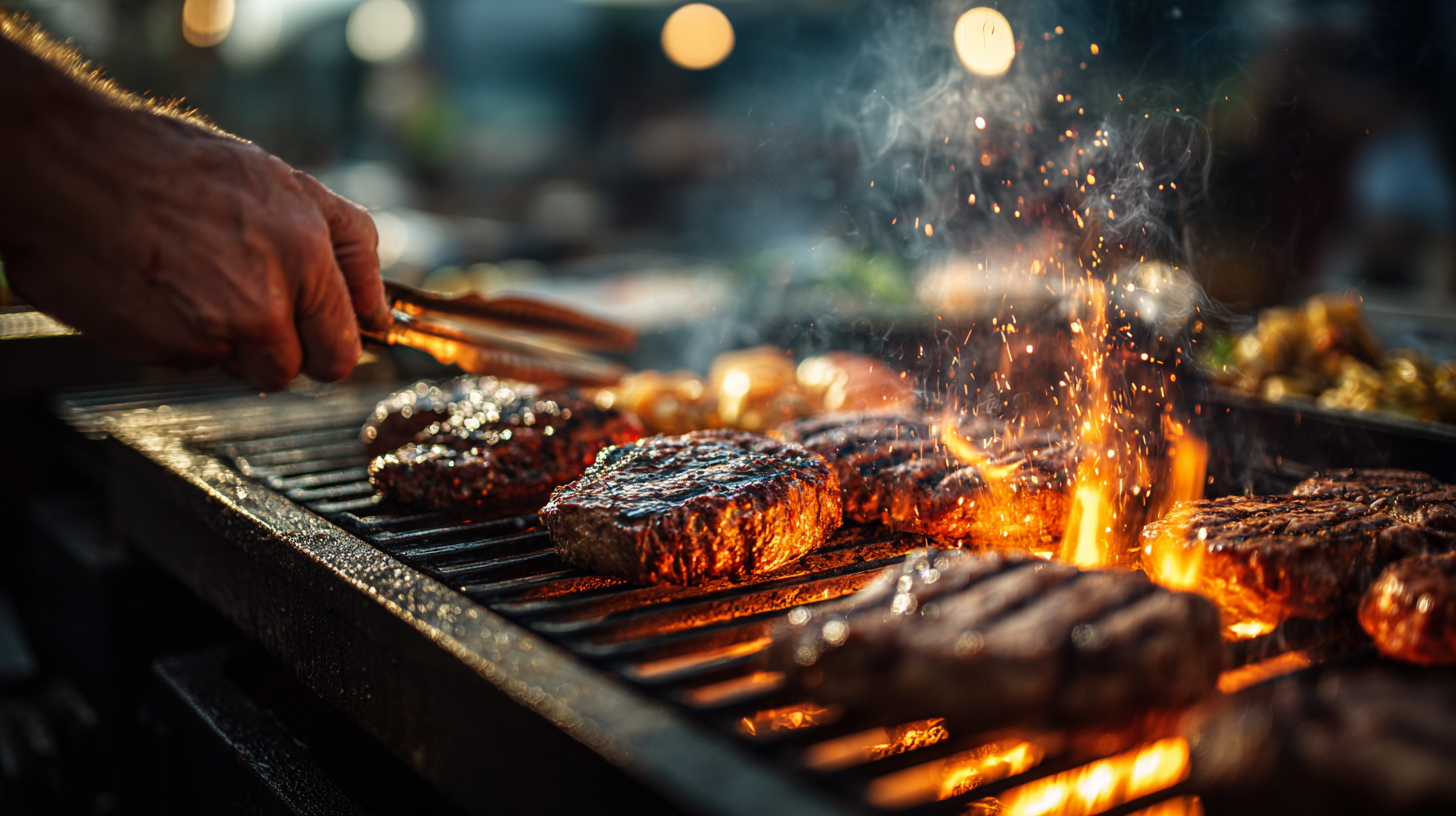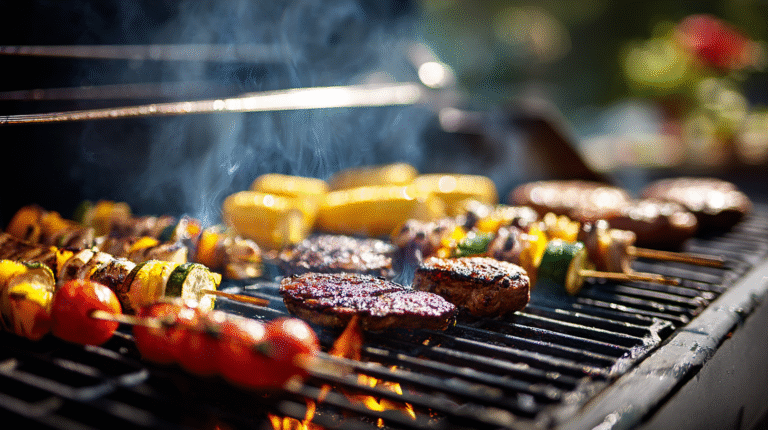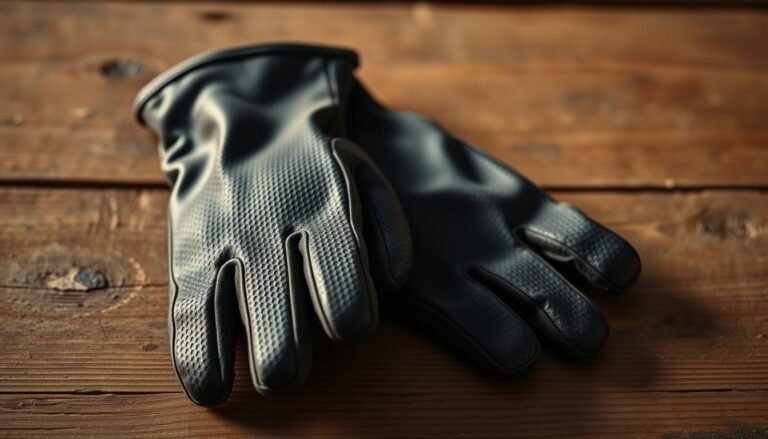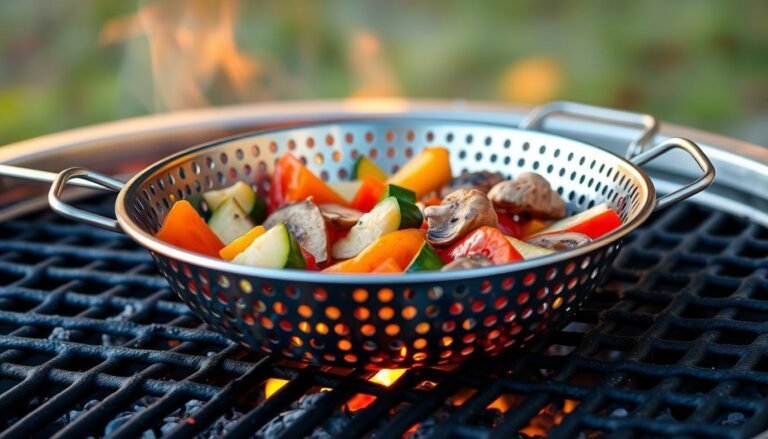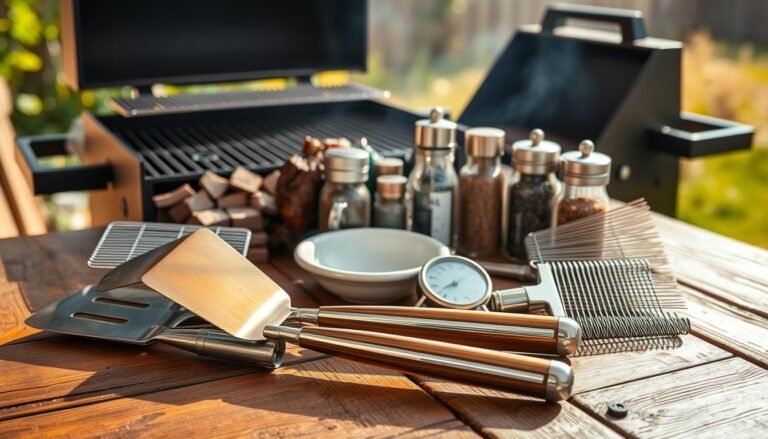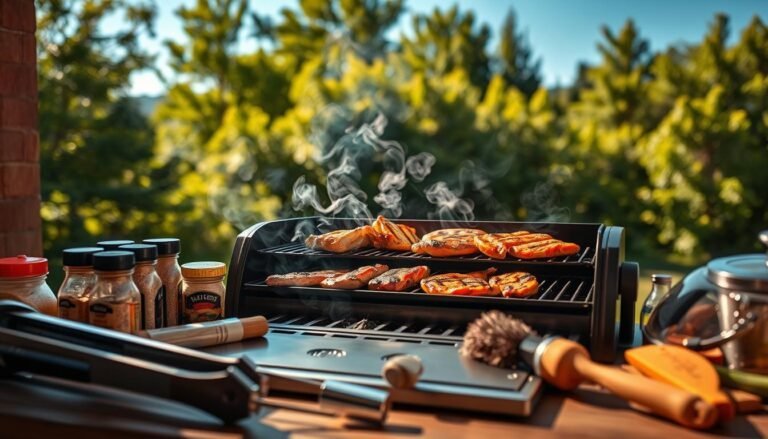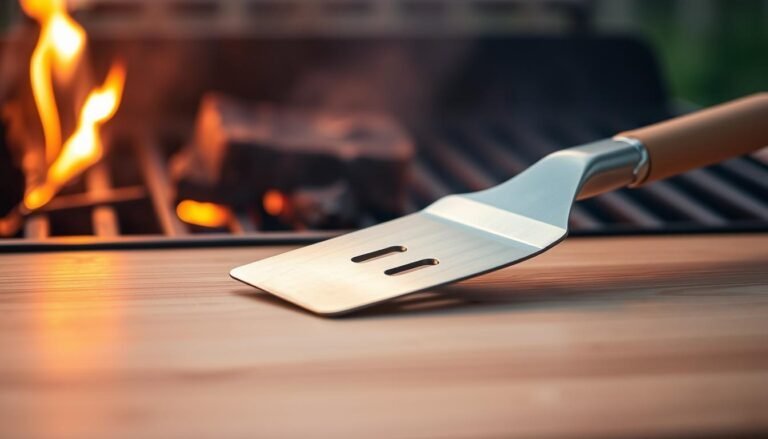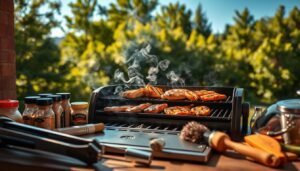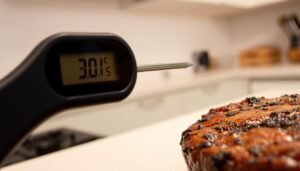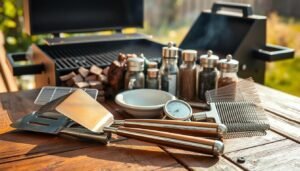Disclosure: This Post Contains Affiliate Links; We earn a commission on purchases.
Grilling is an art that needs precision and control. Mastering grilling techniques is key for perfect food. Understanding heat management for grilling is important. It means dividing the grill into different heat zones.
Dustin Green says temperature control is vital in grilling. By creating heat zones, you can manage the temperature. This lets you get the food just right, every time.
Key Takeaways
- Understanding heat zones is key for perfect grilling.
- Temperature control is vital for the right doneness.
- Dividing the grill into heat zones gives more control.
- Mastering grilling takes practice and patience.
- Heat management is key for perfect grilled food.
The Fundamentals of Grill Heat Management
To grill like a pro, you need to know about heat distribution. Managing heat well is key for perfect dishes. It’s not just about throwing food on the grill. It’s about making different heat areas for different foods.
What Are Heat Zones and Why They Matter
Heat zones are different temperature spots on your grill. They let you cook different foods at the right temperature. By creating grilling hot spots, you can sear steaks and cook veggies just right.
Direct vs. Indirect Heat Explained
Knowing direct and indirect heat is important for grilling. Direct heat is great for quick-cooking foods like steaks and burgers. It gives a nice char on the outside and keeps the inside juicy. Indirect heat is better for slow cooking, like roasting or cooking big cuts of meat. It cooks the meat through without burning the outside.
The Science Behind Effective Heat Distribution
The science of heat distribution is about how heat moves on your grill. Things like grill design, fuel, and grill grate material affect heat. Knowing these helps you manage your grill’s heat zones better, so your food cooks evenly and perfectly.
In conclusion, mastering grill heat management is essential for grilling skills. Understanding heat zones, direct vs. indirect heat, and heat distribution science improves your grilling.
Creating Heat Zones for Perfect Grilled Foods
Learning to manage heat zones is key to grilling success. It lets you cook many dishes perfectly. By knowing how to set up heat zones, you can get the best grilling results.
Two-Zone Setup: The Basic Approach
A two-zone setup is the simplest way to create heat zones. It divides your grill into two parts: one for direct heat and one for indirect. To do this, adjust the burners or coals. This makes one side hot and the other cool. For more on direct vs. indirect grilling, check Martha Stewart’s guide.
- Direct heat zone: Great for searing steaks, burgers, and veggies.
- Indirect heat zone: Best for cooking big cuts of meat, like roasts or whole chickens.
Three-Zone Method: Maximum Versatility
A three-zone setup is for those who want more options. It has a hot zone for searing, a medium zone for cooking, and a cool zone for slow cooking. You can use different burners or adjust coals to get the right temperatures.
The benefits of a three-zone setup include:
- More flexibility for cooking different dishes at once.
- Better control over cooking temperatures.
- The ability to cook a wide range of foods, from fish to roasts.
Understanding Temperature Ranges for Each Zone
To master heat zones on the grill, knowing the temperature ranges is key. Here are the usual temperatures for each zone:
- Hot zone: 400°F – 600°F (200°C – 315°C) for searing and high-heat cooking.
- Medium zone: 300°F – 400°F (150°C – 200°C) for cooking and browning.
- Cool zone: 200°F – 300°F (90°C – 150°C) for warming, slow cooking, or smoking.
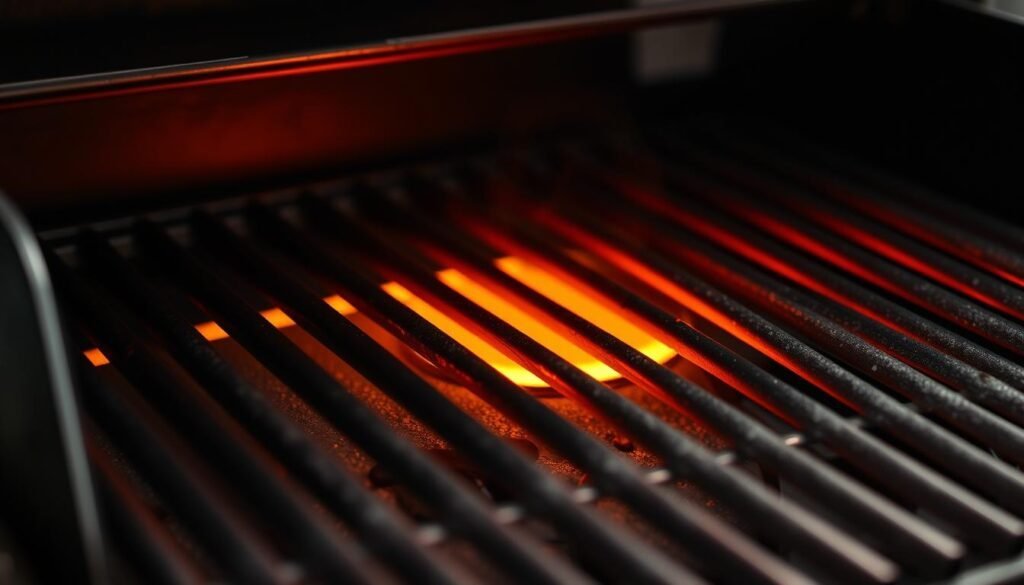
Testing Your Zones Before Cooking
Before cooking, test your heat zones to make sure they’re right. Use a thermometer to check each zone’s temperature. Adjust as needed. This small step can greatly improve your grilled food’s quality.
By following these tips and practicing, you’ll soon master heat zones on the grill. You’ll get perfect grilled foods every time.
Setting Up Heat Zones on Different Grill Types
Grilling techniques depend on setting up and controlling heat zones. This task varies a lot between gas, charcoal, pellet, and electric grills. Knowing these differences is key to grilling food perfectly.
Gas Grill Zone Configuration
Gas grills let you control heat zones well. You can adjust the burners to make different heat areas. For a simple two-zone setup, turn on half the burners for a hot zone and leave the other half off for a cooler zone.
Charcoal Grill Heat Management
Charcoal grills need more work to set up heat zones. You can change the heat by adjusting charcoal amounts and where you put it. For a two-zone fire, put charcoal on one side and leave the other side empty.
Pellet and Electric Grill Adaptations
Pellet and electric grills have their own challenges and chances for heat zone control. Pellet grills often have built-in temperature controls, making it easier to keep heat zones steady. Electric grills might need more creativity, like using heat diffusers or changing the grill’s temperature settings.
Essential Tools for Monitoring and Maintaining Zones
Every grill type needs the right tools for heat zone management. A grill thermometer is a must for accurate temperature checks. Grill mats and heat diffusers also help manage heat.
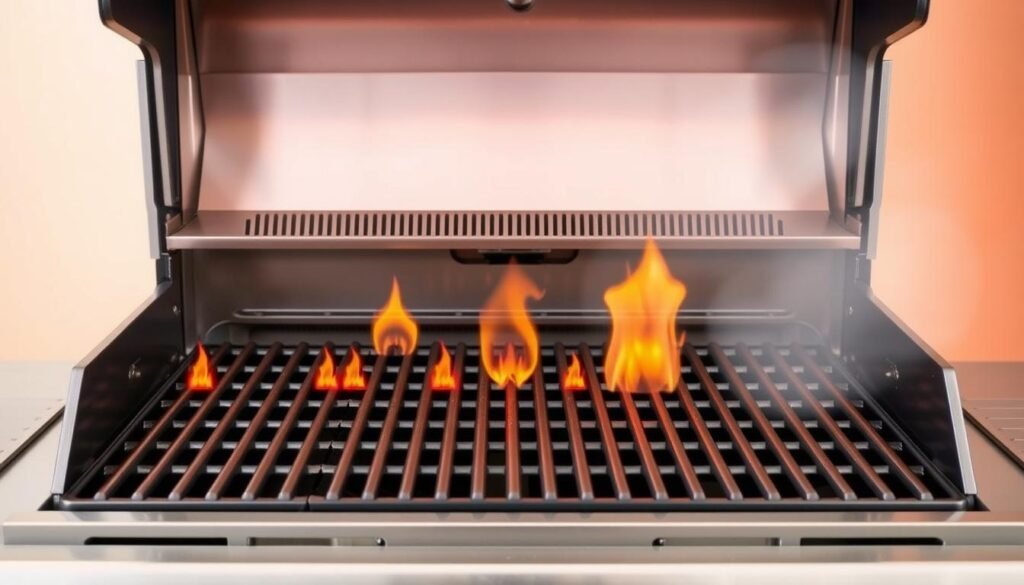
Mastering heat zone setup on your grill opens up many grilling techniques. You can sear steaks or slow-cook veggies. Try different setups and tools to find what works best for you and your grill.
Matching Foods to the Right Heat Zones
Grilling is all about pairing the right food with the right heat. Different foods need specific heat levels for the best taste and texture. Knowing how to match foods with heat zones is key to grilling success.
Red Meats: Steaks, Burgers, and Roasts
Red meats are a big part of grilling. Steaks need high heat to seal in juices, then lower heat to cook to the right doneness. For example, a ribeye steak is seared at 450°F (232°C) for 3-4 minutes each side, then cooked at 300°F (149°C) to get it medium-rare. Burgers also need a good sear, but can cook entirely over medium-high heat. Roasts are best cooked indirectly to cook evenly.
- Steaks: Sear at high heat (400-500°F or 204-260°C), finish at medium-low heat.
- Burgers: Grill over medium-high heat (375-400°F or 190-204°C).
- Roasts: Cook using indirect heat (300-325°F or 149-165°C).
Poultry: Whole Birds and Individual Cuts
Poultry is more delicate than red meat and needs careful heat control. Whole birds should grill over indirect heat for even cooking. Individual cuts like chicken breasts can cook directly over medium heat. Always use a thermometer to check the internal temperature, which should be 165°F (74°C).
- Whole birds: Grill over indirect heat (375-400°F or 190-204°C).
- Chicken breasts: Cook directly over medium heat (350-375°F or 177-190°C).
Seafood: Delicate Cooking Techniques
Seafood is very sensitive to heat and can quickly become overcooked. Delicate fish like sole or flounder should grill over low-medium heat, often in foil to keep moist. Thicker fish steaks or shrimp can grill directly over medium-high heat for a short time.
- Delicate fish: Grill over low-medium heat (300-350°F or 149-177°C), wrapped in foil.
- Shrimp: Cook directly over medium-high heat (400-450°F or 204-232°C) for 2-3 minutes per side.
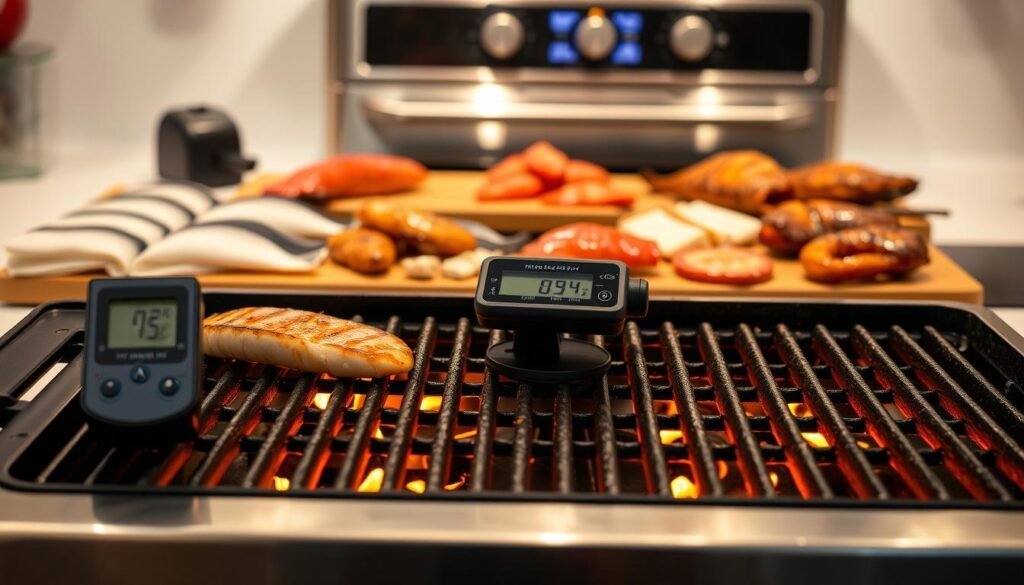
Vegetables and Plant-Based Options
Grilling vegetables and plant-based options adds variety to your barbecue. Most vegetables do well brushed with oil and grilled over medium heat. Bell peppers and zucchini are great choices because they grill quickly and get a nice char.
- Brush vegetables with oil.
- Grill over medium heat (325-375°F or 165-190°C).
Advanced Applications: Smoking, Baking, and Hybrid Cooking
Heat zones are also used for smoking, baking, and hybrid cooking. Smoking is low and slow over indirect heat, perfect for tenderizing tough meats. Baking on the grill uses a pizza stone or cast-iron skillet over medium heat. Hybrid cooking mixes direct and indirect heat for complex dishes.
Mastering the art of matching foods to the right heat zones takes grilling to new heights. It ensures perfectly cooked meals every time.
Conclusion
Learning about heat zones on the grill is key to perfect grilling. It lets you cook foods like juicy steaks and crispy veggies just right. Grilling well means controlling the heat, and heat zones help you do that.
This guide will help you improve your grilling skills. For more tips on grill heat zones and cooking, check out The Ultimate Guide to Grill Heat. With practice, you’ll get better at grilling and make food that tastes great every time.
FAQ
What are heat zones, and why are they important for grilling?
How do I create heat zones on my grill?
What is the difference between direct and indirect heat?
How do I manage temperature zones on a charcoal grill?
What are the essential tools for monitoring and maintaining heat zones?
How do I match foods to the right heat zones?
Can I use heat zones for advanced grilling techniques like smoking and baking?
How do I test my heat zones before cooking?

From quick grilling techniques to simple gear advice, Ryan helps beginners and busy home cooks fire up great meals without over-complicating it. Whether you’re using charcoal, gas, or a portable grill, Ryan’s goal is to make grilling approachable, fun, and full of flavor.
Subscribe to Our Newsletter
